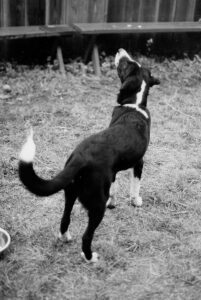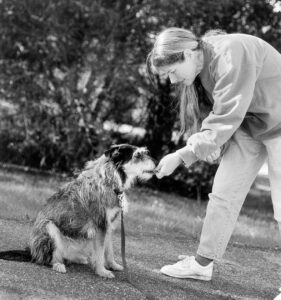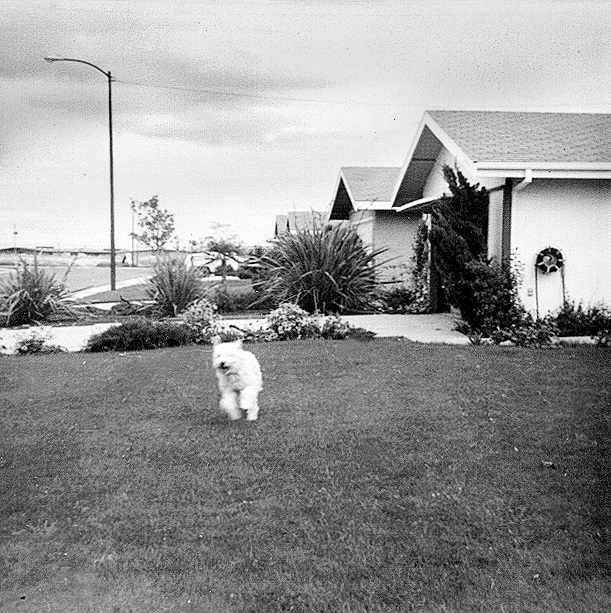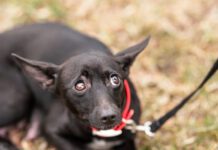[Updated Dec 20, 2022]
When I was younger and much more foolish than I am today, I did a very stupid thing. I took my 12-week-old Australian Kelpie puppy to help me staff a humane society booth at the county fair, and stayed to the very end to watch the evening’s fireworks display.
With the onset of the first deafening pyrotechnic boom and ensuing panoply of brilliant lights, Keli urinated in my lap and struggled frantically to escape. I tried to comfort her as the show continued, but she was in a total, unmitigated panic. I couldn’t have engineered a more perfect way to create a noise-phobic dog if I had tried. For the rest of her 14 years, Keli trembled violently in fear and crawled under the bed during thunderstorms (fortunately a rare occurrence in California) and whenever 4th of July and New Year firecrackers rocked the tranquillity of the neighborhood.
Preventing Noise Phobias in Dogs
Many behaviorists and dog trainers believe that puppies go through a so-called “fear imprinting” period sometime between the ages of eight to 20 weeks, when they learn what is safe in the big wide world, and what is not. Exposure to traumatic stimuli during this period can have long-lasting effects, as the fireworks did with Keli.
The same exposure outside this critical period might temporarily frighten a dog, but is much less likely to do permanent damage to her psyche. Obviously then, the first step in dealing with noise phobias is prevention. During this “fear imprinting” period of a young pup’s life, it is imperative to take extra precautions to see that she isn’t traumatized by unusually loud or sudden noises.
Even later on in a dog’s life, it is important to avoid experiences, such as confining the dog near a noise-producing object, that might trigger an unhealthy fear of loud noises. There may actually be a genetic predisposition for the development of fearful behaviors, which would help to explain why one dog can tolerate repeated noisy stimuli with impunity, while another needs only one exposure to the same stimulus to develop a severe behavior problem. But what do we do about the thousands of noise-phobic dogs for whom prevention is no longer an option? The damage has already been done. Are they doomed, like Keli, to spend the rest of their lives hiding under the bed whenever storm clouds gather?
It is a serious concern. Animal shelters universally report that July 5th and January 1st are the two busiest days of the year in their kennels, caring for dogs who escaped the night before. Fear-induced adrenaline causes dogs to scale fences that would normally be more than adequate to keep them safely confined. Some even go through plate-glass windows and dig through doors in their frantic attempts to escape the torment of the noise.
Fortunately, there are ways to desensitize noise-phobic dogs. It takes time and a real commitment on the part of the dog owner to follow through on a noise desensitization program, but such programs, if followed faithfully, do have a good chance of succeeding.
Dogs and Thunderstorms
Noise-phobic dogs, often labeled “gun shy,” may react to firecrackers, gunshots, cars backfiring, cap guns, wood chopping, falling pots and pans and any other loud noise. But by far the most common stimulus that triggers noise phobia in dogs is the thunderstorm.
Thunderstorms offer a number of potential fear-producing stimuli, including the noise of thunder, wind and rain, flashes of lightning, changes in atmospheric pressure, ionization and storm-related odors. While they may all play a role in thunderstorm phobias, the most overpowering and easiest of the thunderstorm stimuli to replicate for modification work is the noise component.
The two most common approaches to behavior modification involve either desensitization and counter-conditioning, or flooding and habituation (see “Behavioral Definitions,” below). Medications have been used in noise phobia treatment with mixed success. While they may help to calm and control a dog during a storm and prevent self-inflicted injury, they seem to have little long-term effect on the dog’s fear. Also, drugs may actually inhibit a dog’s ability to learn that the storm is not frightening.
Desensitization/counter-conditioning and flooding/habituation are opposite approaches; one can’t do both at the same time. Flooding can be extremely traumatic, and once embarked upon must be followed to its conclusion in order to be successful. This can take many hours, and if the session is stopped before the dog relaxes and accepts the noise, it is likely to just make the problem worse – the dog may think that it was the fearful behavior that finally succeeded in making the noise stop. Flooding is commonly used in the treatment of human fears and phobias, but much less so in dogs.
Desensitization and counter-conditioning, on the other hand, are used together frequently and successfully to overcome canine fears. We can’t use real storms in a desensitization program. Real storms happen too quickly to allow for the gradual increase in intensity that is necessary for desensitization to succeed. However, we can create artificial, controllable thunderstorms through the creative use of stereo equipment, recordings of thunder, strobe lights (to simulate lightning) and sprinklers or hoses to create the sound of rain on the window or roof.
Phobia: A non-useful, counter-productive fear response that is out of proportion to the real level of threat posed by the stimulus.
Counter-conditioning: A technique by which an animal is conditioned to respond in ways that are incompatible with an undesirable response, by gradually presenting the feared stimulus while the animal is engaged in a pleasurable activity (such as eating food). Ideally the stimulus is presented at a level that does not evoke a fear reaction at any time. (Usually performed simultaneously with desensitization.)
Desensitization: A technique used to reduce fear responses in a step-by-step process by exposing the animal initially to non-fearful stimuli and gradually increasing the intensity of the stimuli without evoking a fear response.
Flooding: A fear-removal technique whereby an animal is continuously exposed to a full-strength fear-causing stimulus until the animal stops exhibiting the fearful behavior. The stimulus is not removed until some time after the animal has completely relaxed. At the end of the session the animal is experiencing the full-strength stimulus in a non-fearful state of mind. We do not recommend using this technique.
Habituation: The decrease or loss of response to a fear-inducing stimulus solely as the result of repeated exposure to that stimulus without the use of pleasant or aversive associations (rewards or punishments).
Desensitizing Your Dog to Noise
Begin your behavior modification program by finding a recording (or combination of recording and other stimuli) that causes your dog to react fearfully. Thunderstorm recordings on tape or CD are available at most music outlets. As soon as the dog begins to show fear of the stimuli, turn them off. You don’t want to evoke a full fear response; you just want to find the level at which your dog begins to respond.

Once the dog is totally relaxed again you can begin the training program. Start by playing the recording below the level that would evoke a fearful response. This may be at a level that you cannot even hear. Remember that your dog’s hearing is infinitely better than yours. After five minutes or so, increase the sound slightly. (This is the desensitization part.) While your dog is still calm, feed him absolutely wonderful treats – roast beef or steak, fried chicken skins, or anything else that your dog would normally do backflips for. (This is the counter-conditioning part.) You want him to think that absolutely wonderful things happen when thunderstorm noises occur.
Be generous with totally terrific treats, petting, and praise, and keep the sound at each level for several minutes before gradually increasing the volume again. At some point, your dog will start to exhibit a mild, fearful reaction. (If it is not mild, you have increased the volume too quickly.) Watch for panting, pacing, clinging to you, and other signs of tension. When this happens you have two choices. You can either immediately turn the volume back down, or wait and see if the dog habituates to that level of intensity. If the reaction is truly mild and you have been very gradually increasing the volume, it is preferable to wait for habituation.
Keep the volume at this level for a considerable period of time before increasing the volume again (the exact definition of “considerable period of time” depends on the individual dog). As soon as the dog relaxes – when the signs of stress go away – resume treat-feeding and petting.
Try Never to Invoke a Fear Response
It is important not to play the recording too loudly or to increase the volume too quickly. This is the most common mistake made in desensitization programs – increasing the stimuli level too rapidly. It is very important not to evoke a fear response that does not habituate during the session; this would be a major step backward. Be patient. While the first few sessions may proceed slowly, typically subsequent sessions will go much faster. It often takes only three to five sessions to move past the initial volume level at which the dog first reacted fearfully. This can be accomplished in less than a week.
Once your dog accepts loud thunderstorm noises, reduce the volume and add the other stimuli, one at a time, until he is comfortable with the entire package. Each time you add a new stimulus, reduce the intensity of the others and gradually increase them again, one at a time.
You will also want to change locations from time to time, so the dog accepts the stimuli package in any room of the house. Later on, the onset of the artificial storm should occur outside of formal training sessions – at first perhaps while the dog is playing with a favorite toy, or eating dinner, then at other random times.
When your dog is comfortable with storm noises in all of these situations, you can set your storm on a timer to play at very low levels for very short intervals (at first) when you are not home. Don’t forget: Every time you change an aspect of the exercise you must reduce the intensity of each element of the stimulus package.
Your Dog May Take a While
Studies indicate that frequent, long desensitization/counter-conditioning sessions (30-45 minutes) are more effective than multiple short ones. Mild to moderate phobias may be successfully treated in just a few weeks. Severe cases can take longer – a month or more is not unusual; sometimes they never come around.

The prognosis for severely affected dogs may not be rosy – studies of desensitization programs for extremely noise-phobic dogs are not very encouraging. Many of these dogs don’t respond. However, this may be because the dogs weren’t being desensitized to the right stimulus. It is important to mimic as many of the elements of the package of thunderstorm stimuli as possible for the greatest chance of success.
It is beneficial to accomplish the desensitization program as quickly as possible. If a real storm occurs during the training process and traumatizes the dog it can set the training back. Where storms are seasonal, it makes sense to start and complete the program during the “off” season. Because the desensitization can apparently fade with time, it is also a good idea to refresh the training once or twice a month.
The Dog-Static-Electricity Theory
Some people believe that it is the build-up of static electricity (and resultant static shocks to the dog) that occurs during a thunderstorm that makes many dogs develop an extreme fear of storms.
This would explain why some dogs hide in bathtubs or wedge themselves behind toilets when a storm hits. Their contact with the porcelain plumbing fixtures is thought to ground them and protect them from shocks. Many storm-phobic dogs are much more calm if they are allowed to “ride out” the storm in a car – maybe because the car protects them from the storm sounds as well as from static shocks.
Some owners report success with laundry no-cling strips. Rubbing these sheets over the dog can also prevent static shocks. It is not an unreasonable theory. The intensity of many dogs’ reactions to storms is comparable to the extreme reaction often seen by dogs who are subjected to shocks from electronic training collars. Driving your dog around in a car during a storm, or rubbing him with laundry no-cling sheets are easy and inexpensive solutions to try.
For noises other than storms, it is a matter of finding an adequate artificial replication of the offending noise and any other relevant stimuli that can be incorporated into a similar program.
While not every noise-phobic dog can be successfully desensitized, behaviorists report a fair degree of success with desensitization programs like the one described above. This is good news to the owners of the thousands of noise-phobic dogs that suffer through thunderstorms and other fear-inducing sounds.
I will never deliberately expose another dog of mine to the fireworks experience that caused Keli’s extreme fear of loud noises. I will always regret that I didn’t know how to better help her recover from the trauma of that exposure. But it’s good to know that I now have the tools to help clients’ dogs break through the barrier of debilitating fear so that they can lead normal canine lives, even on the 4th of July.






Thank you for the awesome article, and sharing your story (poor Keli). We too had noise sensitive dogs, for different reasons, so decided to build an app (Brave Puppy – https://brave-puppy.app) to provide a high quality source of commonly traumatic sounds for dogs. A number of professional breeders & trainers are now using our app for this very purpose. It’s available FREE on Apple and Android.
Thank you again, and I do hope you’ll forgive the plug.
thanks for the app! we have one dog who cares less about gunfire, the other wants to run towards gunfire!